Norfolk
Friday 28th July
Marcus Nash and Group
Below is a copy of Marcus' report.
Day 1 of a three day Summer Tour today. It was bright this morning, sunny at times, but still slightly cool in a very blustery SW wind. It clouded over in the afternoon, but thankfully we managed largely to avoid any showers.
With the sun out first thing this morning, we headed straight over to the Heath to start the day. As we walked out of the car park, a male Bullfinch flew over calling, its pink underparts catching the light. In a quiet corner, out of the wind, we flushed a family of Blackcaps ahead of us along an overgrown hedgerow. We could hear them calling in the blackthorn and eventually first the male, then one of the juveniles, perched out nicely for us.
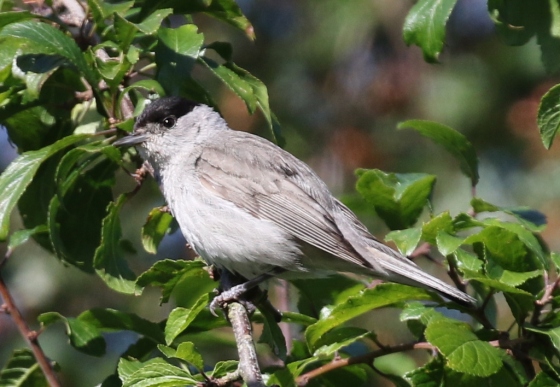
Blackcap - the male perched up nicely for us
Continuing on across the Heath, a Yellowhammer flew up out of the heather and landed in some tall gorse across a clearing. We got it in the scope, a smart male with bright yellow head. We could hear another Yellowhammer singing nearby. There is still a good number of them on the Heath, always a pleasure to see. A Stonechat flicked up onto the top of the heather briefly, before flying across and disappearing round behind a bush. There were lots of Linnets in the gorse all over the Heath, several families with fledged young following the adults around, calling.
There are several pairs of Dartford Warblers up on the Heath, but it felt like it might be a struggle to see them today, given the wind. We walked round through the territory of one pair first, but all was quiet. They were obviously keeping tucked down out of the wind. One of the other pairs has been feeding young in recent days so we decided to try over there instead. Our route across the Heath took us through the territory of a third pair, and we had just been discussing how these are generally the hardest of the Dartford Warblers to see when we heard a burst of song and looked over to see a male Dartford Warblerparachuting back down to the top of the gorse, just finishing a songflight. We were in luck!
We watched the male Dartford Warbler feeding in the top of the gorse for a minute or so, singing occasionally, before it zipped across over an area of heather and into some more gorse further over. We walked part way across and had great views of it feeding in the top of the gorse.
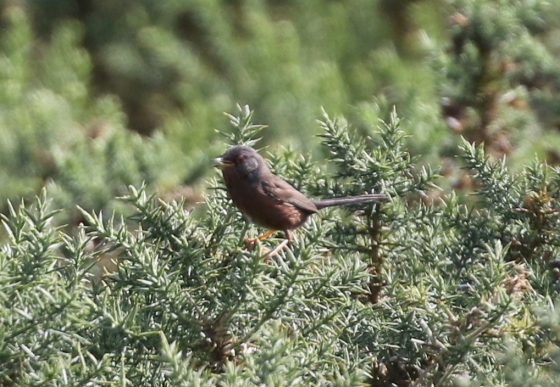
Dartford Warbler - the male, singing on top of the gorse today
Eventually, the Dartford Warbler seemed to disappear back deeper into the gorse. We were just about to move on when it flew out, carrying food in its bill. It flew across in front of us and landed in the gorse where we had first seen it, then flew up again a couple of seconds later and darted across the path and down over the gorse beyond. Presumably it has hungry young somewhere to feed.
The area where the Woodlarks had been gathering food for their young earlier in the summer was quiet now, although we did find a pair of Skylarks there instead, which flew across in front of us and then disappeared away across the Heath. There was no sign of the other pair of Dartford Warblers - they were presumably keeping down out of the wind too. We also checked another area which the Woodlarks have been favouring, but there was no sign of them here either - they have probably fledged their second broods already.
It was a lovely bright morning up on the Heath and there were lots of butterflies out despite the wind. We saw lots of Gatekeepers and several Meadow Browns still, many feeding on the flowering bell heather. A smart Painted Lady was basking in the sun on some ivy growing up a fence. We flushed a Small Copper and a Grayling as we walked across an area of open ground, but both settled back down where we could get a good look at them. The Grayling was very hard to see once it settled and folded back its wings, beautifully camouflaged, even when you knew where it had landed.
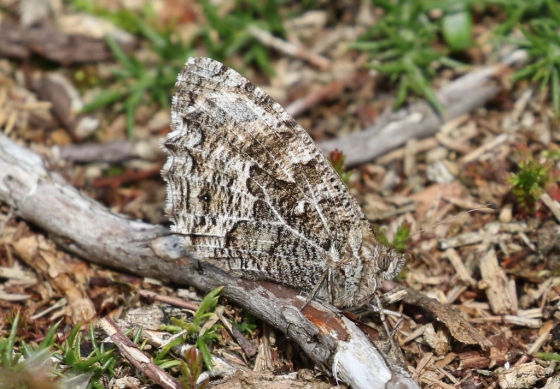
Grayling - beautifully camouflaged
When we got back to the car, we could hear a Garden Warbler singing from the bushes nearby. We walked over to see if we could see it, but it went quiet and never did show itself. Most of the warblers on the Heath have largely stopped singing now, so it was an unexpected bonus to hear this typically skulking species. Several Common Buzzardscircled up over the edge of the Heath.
There was still a little time before lunch, so we dropped down to the coast at Kelling and had a walk down to the Water Meadow. There were a few House Martins around the village and a Greenfinch or two flew off calling from the trees. Otherwise the lane was fairly quiet bird-wise. However, there were a few more butterflies - including a smart Wallbasking on the track and Comma. And there were several dragonflies hawking for insects in the lee of the hedges - a Southern Hawker, a couple of Migrant Hawkers and a very smart, golden-brown winged Brown Hawker.
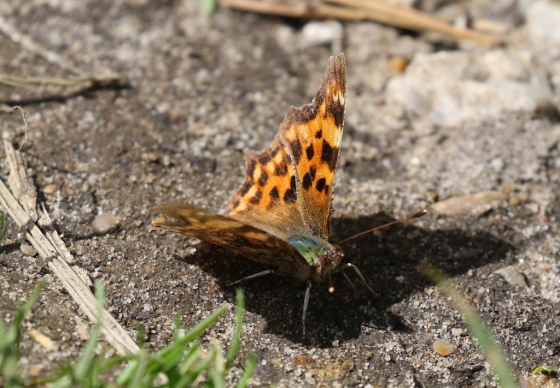
Comma - one or two were feeding along the lane to the Water Meadow
There were a few birds on the pool today. A single Common Sandpiper was the highlight - flying round on flickering bowed wings and calling, before landing on the mud at the far end. There were also several Black-tailed Godwits feeding in the deeper water and a couple of Lapwings on the bank. A few Sand Martins were hawking for insects over the pool and we could see two Egyptian Geese feeding in the rushes at the back. A Grey Heron flew in and landed on the Quag, disturbing all the Rooks gathered in the grass, and a Little Egret was enjoying the sunshine on the edge of the reeds.
It was time for lunch now, so we made our way back to the car and drove along the coast to Cley. After eating our lunch on the picnic tables by the visitor centre, we ventured out onto the reserve. On the walk out to the main hides, we flushed a Reed Warbler from the edge of the reeds and a Bearded Tit flew past calling, before dropping down into the reeds.
The first bird we saw when we got in to Dauke's Hide was a Yellow-legged Gull, standing on the grass on one of the closer islands, preening. We all had a good look at it through the scope, but the next time we looked back it had flown off. The gulls here often drop in and out regularly during the day.
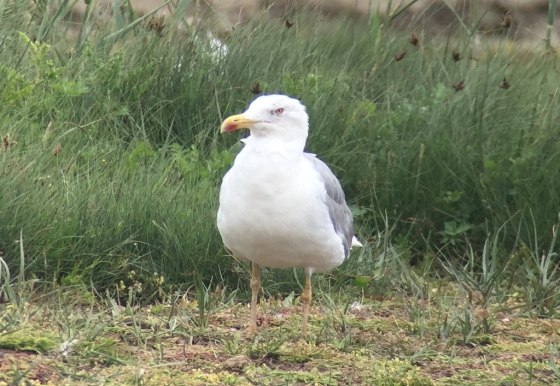
Yellow-legged Gull - showing off its yellow legs, on Simmond's Scrape
There was a nice selection of waders on the scrapes today. The highlight on Simmond's Scrape was the Common Sandpipers, at least three of them. We had a good look at one of them through the scope. A gaudy moulting male Ruff dropped in briefly, but flew off. A single juvenile Dunlin was over towards the back and a small group of Black-tailed Godwits were feeding up to their bellies down at the front.
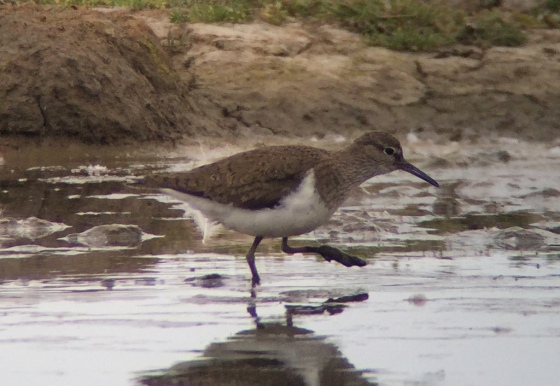
Common Sandpiper - at least three were on Simmond's Scrape
As we made our way across to Teal Hide, we heard Bearded Tits calling from the reeds in the middle of the circular boardwalk right in front of us. It was a family party. We watched as they flew out one by one, across the path and into the taller reeds the other side. We got a good but quick look at a couple of juveniles which perched up in the tops before dropping down out of view.
Round at Teal Hide, there were many more waders, in particular loads of Avocet, Black-tailed Godwit and Ruff, scattered liberally around Pat's Pool.
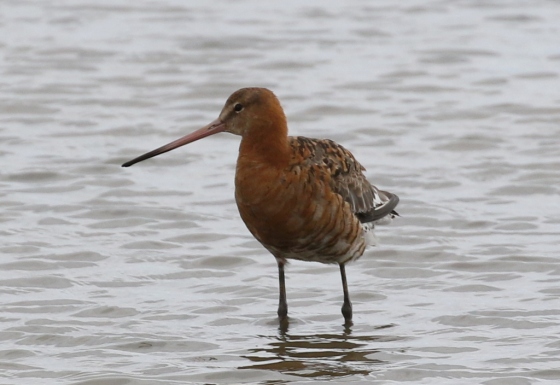
Black-tailed Godwit - in good numbers now at Cley
It didn't take too long to locate the Curlew Sandpiper, a moulting adult with a lot less of its summer rusty colour still on its underparts. Through the scope we could see its comparatively long and downcurved bill. It was feeding on the edge of one of the islands, walking in and out of the grass among the various Ruff. There was a single Knot out on here too, a summer plumaged bird with bright pale orange underparts.
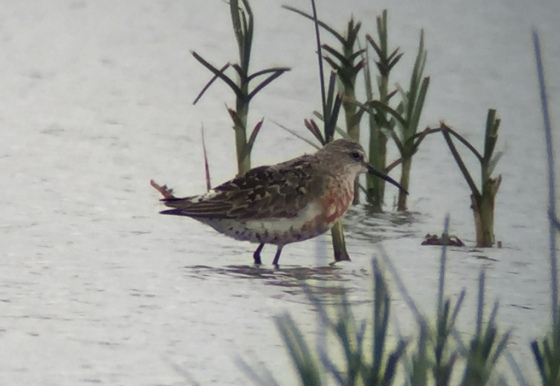
Curlew Sandpiper - rapidly moulting to winter plumage now
We made our way back to the car park and round to the East Bank. It was distinctly cool and blustery now, and it was very exposed up on the bank. A Sedge Warbler flicked off ahead of us in the overgrown vegetation below the bank and we could hear a Reed Warbler singing from the reeds.
There were a few ducks on the Serpentine today, mainly Mallard but we did find a pair of much smaller Teal too. There were lots of Greylag Geese and quite a few Canada Geeseas well, out on the grass.
We could see a small gathering of (3!) photographers ahead of us, so we hurried along to where they were. There had been a Wood Sandpiper along here this morning, at the far end of the Serpentine, and we immediately saw that this was indeed what they were watching. Even better, it was on the mud very close to the bank, so we could get a great look at it. They are very dainty waders, spangled on the back with a bold pale supercilium. It posed very nicely for us, walking into the edge of the grass and preening for a while, before falling asleep.
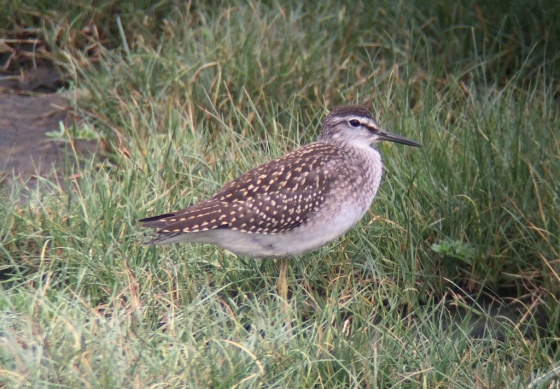
Wood Sandpiper - feeding on the north end of the Serpentine
Eventually we managed to tear ourselves away from watching the Wood Sandpiper, always a very smart bird to see. We walked along a little further and stopped to look at Arnold's Marsh from the new shelter. We had heard the Sandwich Terns calling on the walk out and had seen them all fly round once or twice. From the viewing shelter we could get a much better look at them through the scope, their spiky rear crowns and yellow-tipped black bills. There were quite a few scaly backed juveniles in amongst them and several adults flew in carrying fish while we were watching.
There were more waders on Arnold's Marsh too - lots of Redshank and Black-tailed Godwits, with 2-3 Curlews in with them. Seven Dunlin included a mix of black-bellied adults and streaky-bellied juveniles. A careful scan revealed a single Turnstone too, a smart bird in summer plumage, with bright chestnut patches on its back and a white face.
We had a quick look out to sea from the beach. There were lots of Sandwich Ternsfishing offshore. Just beyond them, a larger white shape with black wing tips circling out over the sea was a lone Gannet. We spotted a wader flying in low over the water, a Curlew, which turned before it got to us and headed west. It was most likely a continental bird just arriving here on its journey from its breeding grounds, possibly in Russia, coming here to moult, perhaps heading round to the Wash.
Then it was time for us to start making our way back. We stopped briefly for another look at the Wood Sandpiper on the way. It was still feeding very close to the path, giving great views. Then suddenly and for no apparent reason it took off and flew past us, heading strongly on west. Maybe it was time for it to continue on its journey south. Further along, we stopped to watch a pair of Reed Warblers, flitting around first in the vegetation on the bank, moving ahead of us. Then they flew across to the far side of the reedy channel, where they started to work their way along the base of the reeds, just above the water, giving a great chance to look at them properly.

Reed Warbler - a pair were feeding along the ditch this afternoon
Then we made our way back to the car. It had been a lovely day out but it was now time to head for home.
No comments:
Post a Comment
Note: only a member of this blog may post a comment.